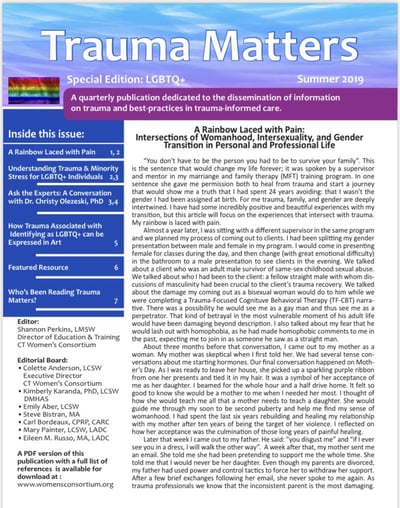Flipping Through The Past: A Look at Trauma Matters

As Editor of Trauma Matters, dozens of fascinating articles cross my desk each month. I am privileged to have the responsibility of refining and cultivating each piece, working so that every issue presents nuanced, thoughtful perspectives on trauma, gender, recovery, racism, and dozens of other topics. Recent editions of Trauma Matters have been some of our best yet, featuring an interview with Department of Children and Families’ Commissioner Dorantes, articles on the intersection of trauma and art, and powerful book reviews.
Last year, we renovated our website and in the process were forced to remove decades worth of Trauma Matters articles from our digital archive. It has taken some time, but I have started to review past editions, looking for articles that we can expand on and for interviews prime for republishing. I’ve enjoyed reading the “Who’s Been Reading Trauma Matters” features — a mainstay in each issue — and have been moved by the thought that went into each edition.
One edition’s timelessness stood out to me: the 2019 Pride edition of Trauma Matters.

Shannon Perkins, then editor, and the whole of the Trauma Matters editorial board put together an engrossing feature including local talents like Christy Olezeski, PhD, an assistant professor at Yale whose expertise lies in the intersection between trauma, sexuality, and gender identity; Olive Byrne, a transgender youth therapist; and the artist Pops Peterson, who discussed expressing his LGBTQ+ identity and trauma in art.
Each article built upon the one before it, painting a comprehensive picture of Pride and the role of LGBTQ+ individuals as both behavioral health experts and clients. But this was not a conversation about the trauma of being gay — or identifying anywhere within the LGBTQ+ community — as many behavioral health articles related to these identities, unfortunately, tend to be. Instead, this was a reflection of co-occurring instances of trauma, improvements that can be and have been made within the behavioral health system, and the potential pitfalls evoked by bias. Peterson made it clear in his article, “How Trauma Associated with Identifying as LGBTQ+ can be Expressed in Art,” stating, “My trauma was never because of something I was, gay, but from something I was not, accepted. My constant craving was to fit in and simply to be counted. To belong and be loved.”
In her interview, Dr. Olezeski asked, “How can we make medical settings more inviting and respectful of all identities? Can we think about talking to families about the impact of acceptance?” These questions place an emphasis on the power of respect and empathy. For clinicians seeking to create an empowering environment, these tools are essential.
The whole of the Trauma Matters archive can be found here.
Subscribe for updates
_.webp)



